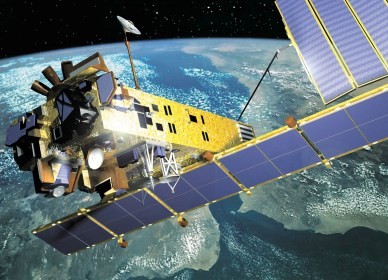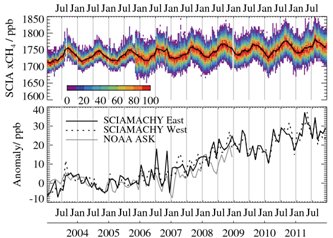{multithumb thumb_width=200}
ENVISAT/SCIAMACHY mission leaves rich scientific heritage
The European space organisation ESA has declared the end of the ENVISAT mission, after all communication was lost. This is a setback for the Earth observation community. But the environmental satellite is a big success. In the past ten years – twice the planned lifespan – ENVISAT has come up with a wealth of new data on for instance the Earth’s atmosphere, the oceans and the ice caps. Ground-breaking information was also delivered by its German-Dutch-Belgian instrument SCIAMACHY which has presented us with a far better insight into for instance the air pollution over the Netherlands and methane emissions in the Tropics. SCIAMACHY’s successor TROPOMI, which is being developed and built for the greater part in the Netherlands in cooperation with ESA, will be launched as soon as 2015.

ENVISAT – the largest Europe an Earth observation satellite ever built – has observed and monitored the Earth’s land, atmosphere, oceans and ice caps for more than a decade. One of the more than ten instruments onboard is the German-Dutch-Belgian SCIAMACHY instrument which was built to perform measurements of the Earth’s atmosphere. Dutch industry and institutes were responsible for the development of the optical unit of SCIAMACHY including the detectors for ultraviolet up to short wave infrared (SWIR) radiation. SRON designed, constructed and tested the detector modules of the SCIAMACHY instrument. Based on the measurements with the SWIR modules SRON also delivers the scientific data products – carbon monoxide (CO), methane (CH4) and heavy water (HDO/H2O).
Air pollution

The SCIAMACHY measurements of nitrogen dioxide (NO2), an important indicator of air pollution, were the first to clearly show the air pollution over the Netherlands in the European context. ‘This alarmed environmentalists and politicians in the Netherlands, who put air quality high on the Dutch political agenda,’ SRON researcher and co-lead scientist Ilse Aben says. SCIAMACHY measurements also determined that elevated concentrations of carbon monoxide (CO) over Australia could be traced back to originate from South American wildfires some 13000 km away.
Climate research

One of the important breakthroughs of SCIAMACHY was the registration of enhanced methane concentrations above the Tropics. ‘Methane is a relatively potent greenhouse gas and an important factor in global warming[F1] ‘ says Aben, ‘so these findings are very relevant. They have inspired a lot of new research, including speculations on new sources of methane.’ SCIAMACHY measurements also gave rise to the conclusion that higher temperatures on the Earth’s surface at higher latitudes cause an increase in the emission of methane. Therefore higher temperatures are not just a consequence of climate change but also a cause of it.

Furthermore the instrument is responsible for the first global observations of heavy water with sensitivity towards the lowest layers of the atmosphere, where most of the water vapour resides. This has enabled us to deepen our current understanding of the hydrological cycle which determines the Earth’s climate to a large extent. Ultimately this leads to better climate models. ‘All in all you could really label ENVISAT/SCIAMACHY one of the giants of Earth observation research,’ says Aben.
TROPOMI
TROPOMI, SCIAMACHY’S successor, is being built right now. After its launch onboard the ESA satellite Sentinel-5 Precursor at the start of 2015 TROPOMI will observe the Earth for more than seven years, at an altitude of 800 kilometers. By combining the high spatial resolution and wide coverage of predecessor OMI (still operational) with SCIAMACHY’s big spectral range TROPOMI can collect an unprecedented amount of crucial information. Researchers expect TROPOMI to render new insight into air pollution, greenhouse gases and the gap in the ozone layer. Aben: ‘Thanks to its high resolution (7 x 7 kilometers, ed.) we can for example trace pollution back to its source in more detail. We will be able to put the TROPOMI data to good use for climate models, predictions of air quality or air traffic warnings in the case of erupting volcanoes.’
The Sentinel-5p satellite is part of the Global Monitoring for Environment and Security (GMES) program of the European Commission and ESA. TROPOMI is a collaboration between KNMI, SRON, TNO and Dutch Space, on behalf of NSO. KNMI and SRON have the scientific lead of the project. Dutch Space in Leiden is the principal contractor for the construction of the instrument. TROPOMI is funded in collaboration with ESA by the Ministry of Economic Affairs, Agriculture and Innovation, the Ministry of Education, Culture and Science and the Ministry of Infrastructure and the Environment.


